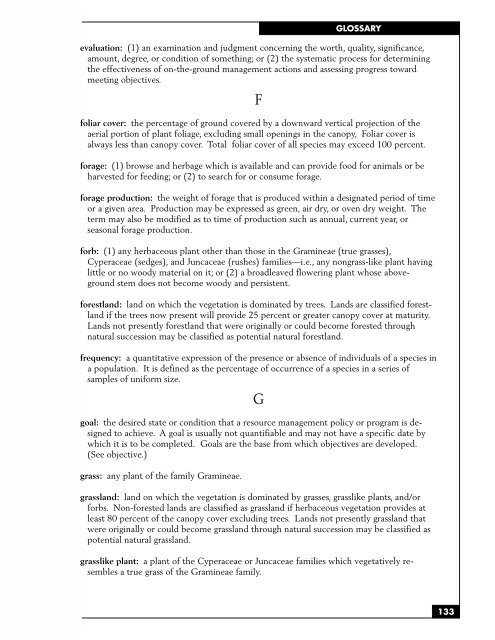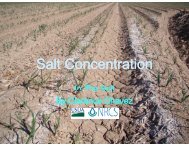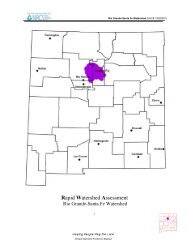SAMPLING VEGETATION ATTRIBUTES - New Mexico NRCS - US ...
SAMPLING VEGETATION ATTRIBUTES - New Mexico NRCS - US ...
SAMPLING VEGETATION ATTRIBUTES - New Mexico NRCS - US ...
Create successful ePaper yourself
Turn your PDF publications into a flip-book with our unique Google optimized e-Paper software.
GLOSSARY<br />
evaluation: (1) an examination and judgment concerning the worth, quality, significance,<br />
amount, degree, or condition of something; or (2) the systematic process for determining<br />
the effectiveness of on-the-ground management actions and assessing progress toward<br />
meeting objectives.<br />
foliar cover: the percentage of ground covered by a downward vertical projection of the<br />
aerial portion of plant foliage, excluding small openings in the canopy, Foliar cover is<br />
always less than canopy cover. Total foliar cover of all species may exceed 100 percent.<br />
forage: (1) browse and herbage which is available and can provide food for animals or be<br />
harvested for feeding; or (2) to search for or consume forage.<br />
F<br />
forage production: the weight of forage that is produced within a designated period of time<br />
or a given area. Production may be expressed as green, air dry, or oven dry weight. The<br />
term may also be modified as to time of production such as annual, current year, or<br />
seasonal forage production.<br />
forb: (1) any herbaceous plant other than those in the Gramineae (true grasses),<br />
Cyperaceae (sedges), and Juncaceae (rushes) families—i.e., any nongrass-like plant having<br />
little or no woody material on it; or (2) a broadleaved flowering plant whose aboveground<br />
stem does not become woody and persistent.<br />
forestland: land on which the vegetation is dominated by trees. Lands are classified forestland<br />
if the trees now present will provide 25 percent or greater canopy cover at maturity.<br />
Lands not presently forestland that were originally or could become forested through<br />
natural succession may be classified as potential natural forestland.<br />
frequency: a quantitative expression of the presence or absence of individuals of a species in<br />
a population. It is defined as the percentage of occurrence of a species in a series of<br />
samples of uniform size.<br />
G<br />
goal: the desired state or condition that a resource management policy or program is designed<br />
to achieve. A goal is usually not quantifiable and may not have a specific date by<br />
which it is to be completed. Goals are the base from which objectives are developed.<br />
(See objective.)<br />
grass: any plant of the family Gramineae.<br />
grassland: land on which the vegetation is dominated by grasses, grasslike plants, and/or<br />
forbs. Non-forested lands are classified as grassland if herbaceous vegetation provides at<br />
least 80 percent of the canopy cover excluding trees. Lands not presently grassland that<br />
were originally or could become grassland through natural succession may be classified as<br />
potential natural grassland.<br />
grasslike plant: a plant of the Cyperaceae or Juncaceae families which vegetatively resembles<br />
a true grass of the Gramineae family.<br />
133




